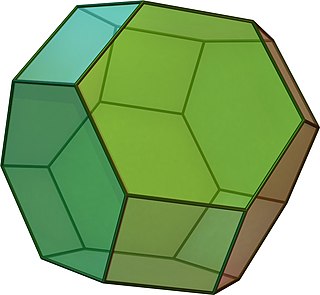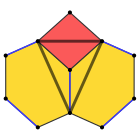
Back Octàedre truncat Catalan Oktaederstumpf German Κόλουρο οκτάεδρο Greek Senpintigita okedro Esperanto Octaedro truncado Spanish Oktaedro moztu Basque هشتوجهی بریدهشده Persian Octaèdre tronqué French תמניון קטום HE Ottaedro troncato Italian
| Truncated octahedron | |
|---|---|
 (Click here for rotating model) | |
| Type | Archimedean solid Uniform polyhedron |
| Elements | F = 14, E = 36, V = 24 (χ = 2) |
| Faces by sides | 6{4}+8{6} |
| Conway notation | tO bT |
| Schläfli symbols | t{3,4} tr{3,3} or |
| t0,1{3,4} or t0,1,2{3,3} | |
| Wythoff symbol | 2 4 | 3 3 3 2 | |
| Coxeter diagram | |
| Symmetry group | Oh, B3, [4,3], (*432), order 48 Th, [3,3] and (*332), order 24 |
| Rotation group | O, [4,3]+, (432), order 24 |
| Dihedral angle | |
| References | U08, C20, W7 |
| Properties | Semiregular convex parallelohedron permutohedron zonohedron |
 Colored faces |
 4.6.6 (Vertex figure) |
 Tetrakis hexahedron (dual polyhedron) |
 Net |

In geometry, the truncated octahedron is the Archimedean solid that arises from a regular octahedron by removing six pyramids, one at each of the octahedron's vertices. The truncated octahedron has 14 faces (8 regular hexagons and 6 squares), 36 edges, and 24 vertices. Since each of its faces has point symmetry the truncated octahedron is a 6-zonohedron. It is also the Goldberg polyhedron GIV(1,1), containing square and hexagonal faces. Like the cube, it can tessellate (or "pack") 3-dimensional space, as a permutohedron.
The truncated octahedron was called the "mecon" by Buckminster Fuller.[1]
Its dual polyhedron is the tetrakis hexahedron. If the original truncated octahedron has unit edge length, its dual tetrakis hexahedron has edge lengths 9/8√2 and 3/2√2.
- ^ "Truncated Octahedron". Wolfram Mathworld.
© MMXXIII Rich X Search. We shall prevail. All rights reserved. Rich X Search

